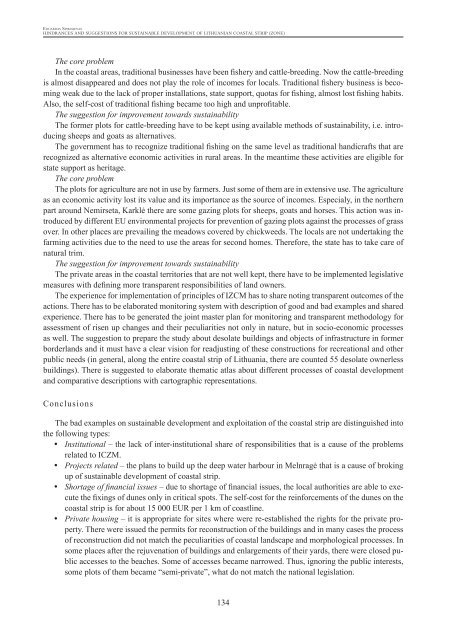Regional Formation 2012,1 - KlaipÄdos universitetas
Regional Formation 2012,1 - KlaipÄdos universitetas
Regional Formation 2012,1 - KlaipÄdos universitetas
Create successful ePaper yourself
Turn your PDF publications into a flip-book with our unique Google optimized e-Paper software.
Eduardas Spiriajevas<br />
HINDRANCES AND SUGGESTIONS FOR SUSTAINABLE DEVELOPMENT OF LITHUANIAN COASTAL STRIP (ZONE)<br />
The core problem<br />
In the coastal areas, traditional businesses have been fishery and cattle-breeding. Now the cattle-breeding<br />
is almost disappeared and does not play the role of incomes for locals. Traditional fishery business is becoming<br />
weak due to the lack of proper installations, state support, quotas for fishing, almost lost fishing habits.<br />
Also, the self-cost of traditional fishing became too high and unprofitable.<br />
The suggestion for improvement towards sustainability<br />
The former plots for cattle-breeding have to be kept using available methods of sustainability, i.e. introducing<br />
sheeps and goats as alternatives.<br />
The government has to recognize traditional fishing on the same level as traditional handicrafts that are<br />
recognized as alternative economic activities in rural areas. In the meantime these activities are eligible for<br />
state support as heritage.<br />
The core problem<br />
The plots for agriculture are not in use by farmers. Just some of them are in extensive use. The agriculture<br />
as an economic activity lost its value and its importance as the source of incomes. Especialy, in the northern<br />
part around Nemirseta, Karklė there are some gazing plots for sheeps, goats and horses. This action was introduced<br />
by different EU environmental projects for prevention of gazing plots against the processes of grass<br />
over. In other places are prevailing the meadows covered by chickweeds. The locals are not undertaking the<br />
farming activities due to the need to use the areas for second homes. Therefore, the state has to take care of<br />
natural trim.<br />
The suggestion for improvement towards sustainability<br />
The private areas in the coastal territories that are not well kept, there have to be implemented legislative<br />
measures with defining more transparent responsibilities of land owners.<br />
The experience for implementation of principles of IZCM has to share noting transparent outcomes of the<br />
actions. There has to be elaborated monitoring system with description of good and bad examples and shared<br />
experience. There has to be generated the joint master plan for monitoring and transparent methodology for<br />
assessment of risen up changes and their peculiarities not only in nature, but in socio-economic processes<br />
as well. The suggestion to prepare the study about desolate buildings and objects of infrastructure in former<br />
borderlands and it must have a clear vision for readjusting of these constructions for recreational and other<br />
public needs (in general, along the entire coastal strip of Lithuania, there are counted 55 desolate ownerless<br />
buildings). There is suggested to elaborate thematic atlas about different processes of coastal development<br />
and comparative descriptions with cartographic representations.<br />
Conclusions<br />
The bad examples on sustainable development and exploitation of the coastal strip are distinguished into<br />
the following types:<br />
• y Institutional – the lack of inter-institutional share of responsibilities that is a cause of the problems<br />
related to ICZM.<br />
• y Projects related – the plans to build up the deep water harbour in Melnragė that is a cause of broking<br />
up of sustainable development of coastal strip.<br />
• y Shortage of financial issues – due to shortage of financial issues, the local authorities are able to execute<br />
the fixings of dunes only in critical spots. The self-cost for the reinforcements of the dunes on the<br />
coastal strip is for about 15 000 EUR per 1 km of coastline.<br />
• y Private housing – it is appropriate for sites where were re-established the rights for the private property.<br />
There were issued the permits for reconstruction of the buildings and in many cases the process<br />
of reconstruction did not match the peculiarities of coastal landscape and morphological processes. In<br />
some places after the rejuvenation of buildings and enlargements of their yards, there were closed public<br />
accesses to the beaches. Some of accesses became narrowed. Thus, ignoring the public interests,<br />
some plots of them became “semi-private”, what do not match the national legislation.<br />
134
















